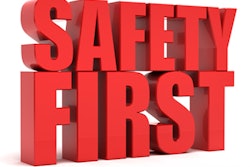
Pediatric patients younger than 6 years old are the most vulnerable when it comes to MRI safety issues, according to a study performed at Massachusetts General Hospital (MGH) in Boston and presented at RSNA 2016. The findings have prompted a call for quality improvements when it comes to scanning kids.
The good news is that almost all the incidents that were tracked caused no serious injury to the children, but the rate of pediatric MRI safety reports at MGH exceeded that of the hospital's adult population. Lapses in service coordination and adverse drug reactions were the most common reasons for the reports.
"The most important point of the discussion is for children less than 6 years of age," said lead author Dr. Camilo Jaimes from MGH. "That is where we should focus initially if we are to have a strong and rapid effect on quality and safety for MRI."
MRI on the rise
The past couple of years have seen a rise in the utilization of pediatric MRI, Jaimes told RSNA attendees.
 Dr. Camilo Jaimes from Massachusetts General Hospital.
Dr. Camilo Jaimes from Massachusetts General Hospital."There are more scanners available, and we have been shying away from modalities that use ionizing radiation," he said. "Although MRI is of minimal risk, it is not risk-free, but we have very limited data on what the risks are when we use MRI on children."
Compared with adults, pediatric patients pose unique challenges for clinicians. There often is a greater need for sedation to calm a naturally nervous or fidgety child.
"In general, the majority of children who are sedated are under the age of 6," Jaimes said to AuntMinnie.com. "The MRI scanner is not comfortable for anyone, but it is very hard to reason with a 6-year-old to hold still. So age and sedation go hand in hand, along with age and the physical vulnerability of children through medication such as the anesthetic."
The purpose of the MGH study was to estimate the rate of safety reports from pediatric MRI scans, determine the risk factors, and generate evidence-based recommendations to reduce adverse events.
The retrospective study queried the RIS at MGH for patients 18 years and younger who underwent an MRI scan beginning in January 2010 through December 2015. The researchers gathered data on the patients' age and gender, whether they were sedated or received general anesthesia, and if the scans were conducted as an inpatient, outpatient, or through the emergency room (ER). In all, 16,748 MRI scans met the study criteria.
Jaimes and colleagues tallied a number of factors, including the reason for the MRI scan, any adverse drug or contrast agent reactions, complications from anesthesia, IV issues, and glitches in service coordination. Only a minority of scans (21%) were performed with sedation, while most of the procedures were conducted on an outpatient basis (79%).
The severity of safety reports were graded on a five-point scale from 0 to 4:
- Grade 0 -- No safety issue
- Grade 1 -- Minimal effect on the patient but no damage or injury
- Grade 2 -- Mild or temporary damage
- Grade 3 -- Severe or permanent harm
- Grade 4 -- Death or a "lethal event"
Safety reports
The researchers counted 88 safety incident reports among the 16,748 MRI scans reviewed for a frequency rate of 0.52%. That number incidentally is greater than the adult rate of 0.35% for safety incident reports at MGH as reported in an earlier 2016 study (Journal of Magnetic Resonance Imaging, April 2016, Vol. 43:4, pp. 998-1007).
The highest safety report rate (1.1%) was among children between 1 month and 1 year old, followed by newborns younger than 1 month old (0.9%) and toddlers between 4 and 6 years (0.9%). The rate then decreased to 0.4% for pediatric patients older than 6 years.
Fortunately, the majority of the safety reports (96%) resulted in no harm or only minor injury to the children. Only four reports involved severe injury, and there were no deaths reported.
| Severity of safety incidents | |
| Grade | No. |
| Grade 0 | 12 |
| Grade 1 | 40 |
| Grade 2 | 32 |
| Grade 3 | 4 |
| Grade 4 | 0 |
The safety report frequency rate (1.1%) was greater among inpatients, who generally need more acute care. The frequency rate for emergency room patients was 0.6%, followed by outpatients at 0.4%. In addition, patients who were sedated had a safety report rate of 0.8%, compared with 0.4% for young patients who received no sedation or anesthesia.
Service issues
Most of the safety reports were related to service coordination (34%), followed by adverse drug reactions (19%) and errors in diagnostic tests performed or ordered (11%). It is not a great surprise that service coordination would receive a high number of safety reports, since it is interrelated with other hospital functions, Jaimes said.
"The higher frequency of sedation and anesthesia in children heavily affects the service coordination, because the moment you bring in sedation and anesthesia, you involve a whole other department into the equation," he said. "You have to coordinate the scanner to make sure it works, coordinate with patient transport, and coordinate with anesthesia and recovery services."
Such challenges are also "more clinically relevant in children," Jaimes added. Take, for example, a child having to fast before an imaging exam.
"If you are a newborn or an infant, you have to eat every certain number of hours, otherwise you will become hypoglycemic," he said. "Prolonging a fast is quite different when it involves children. Additional services need to be consulted, including sedation and anesthesia and child life specialists."
The researchers also found that the number of adverse drug reactions was due to allergies to medications or a gadolinium-based MRI contrast agent. The safety report rate in this category was approximately the same as in an adult population, Jaimes said.
"Those [reactions] are very hard to prevent, especially when it is [administered] for the first time," he added. "We cannot anticipate that the child will be allergic to the medication or contrast, but we can prevent it the second time."
Suggested remedies
Jaimes recommended that the initial focus of safety measures should target pediatric patients younger than 6 years old, since they accounted for the vast majority of reports. He suggested utilizing technical innovations such as pediatric head coils, which can be tailored to fit newborns and young infants. In addition, MRI software and new MRI pulse sequences can hasten scan time to reduce the need for sedation and correct for unexpected pediatric patient motion.
"I also would suggest we use the resources we already have on hand, such as child life specialists and pediatric-friendly environments," he said. "Interventions should focus on younger children, such as those younger than 6 years old, those who need sedation, and those who require acute medical care such as inpatients and ER patients."


.fFmgij6Hin.png?auto=compress%2Cformat&fit=crop&h=100&q=70&w=100)





.fFmgij6Hin.png?auto=compress%2Cformat&fit=crop&h=167&q=70&w=250)











